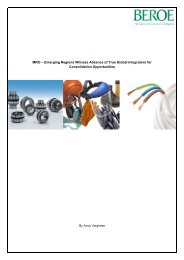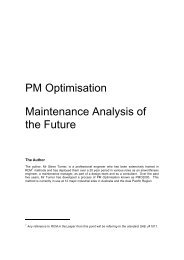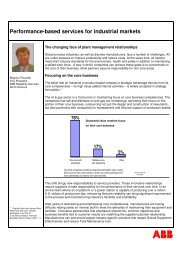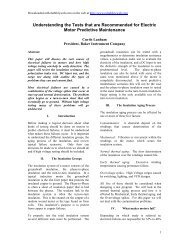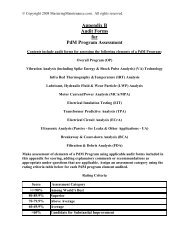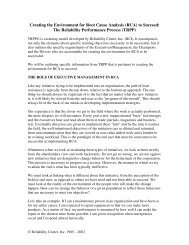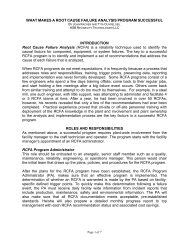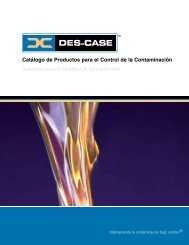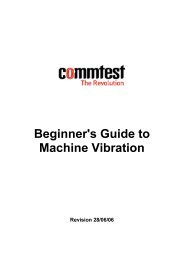Effective Maintenance Program Development/Optimization
Effective Maintenance Program Development/Optimization
Effective Maintenance Program Development/Optimization
You also want an ePaper? Increase the reach of your titles
YUMPU automatically turns print PDFs into web optimized ePapers that Google loves.
Downloaded from Reliabilityweb.com on the web at http://www.reliabilityweb.cominclude production levels, products qualities, safe operation policies and requirements,environmental integrity requirements, and operating cost targets.Objectives are then translated to major assets’ specific performance expectations.Measures at this level might include availability, asset utilization, efficiency, specificproducts qualities, Overall Equipment <strong>Effective</strong>ness (OEE), cost per unit produced, etc.Target values are set by plant operating departments and approved by plant and corporatemanagement.Major assets or systems performance expectations are further refined to the individualequipment level. Here target vales for measures, such as Mean Time Between Failure(MTBF), Mean Time To Repair (MTTR), availability, etc., are set and approved.This process is repeated periodically, and the objectives are changed to reflect thecompany’s position regarding the main business drivers. Figure 2 identifies the stepsinvolved in developing asset performance expectations.Business objectives and performance expectations set the stage for defining equipmentperformance standards for high risk equipment in which RCM2 is the utilized method fordeveloping/optimizing the maintenance programs.4.0 Plant Technical ModelThe plant technical model (also known as asset hierarchy) is composed of a hierarchy ofsystems and sub-systems that gradually represent increased levels of detail in describingthe asset. The model reflects how systems and sub-systems fit together, interrelate andoperate to provide the intended business function. As such, the hierarchy reflects both thestructural and process flow characteristics of the plant/asset.The model starts with the process flow diagram representing the overall operation of aplant. This level consists of the major plant production units, utility systems (such aselectricity, water, steam, air, fuel, etc.), feed and raw material preparation facilities, finalproduct storage, plant control systems and local area network(s), infrastructures, etc.The next level breaks down each unit into systems and sub-systems as depicted on unitprocess flow diagram and P&ID’s. Examples at this level include systems such as feedfiltration, feed pressurization, feed heating, atmospheric fractionation, etc. Atprogressively lower levels of the model, the breakdown of the plant becomes moredetailed. At the end, the plant is reduced to a set of systems and sub-subsystems and theequipment items that support each one of the systems or sub-sub-systems.Control and protective systems are incorporated in the hierarchy at the appropriate levels.In the case where a control or protective system is dedicated to one system or sub-systemthen it should be setup as a sub-element of that system. In the case that aPage 3



